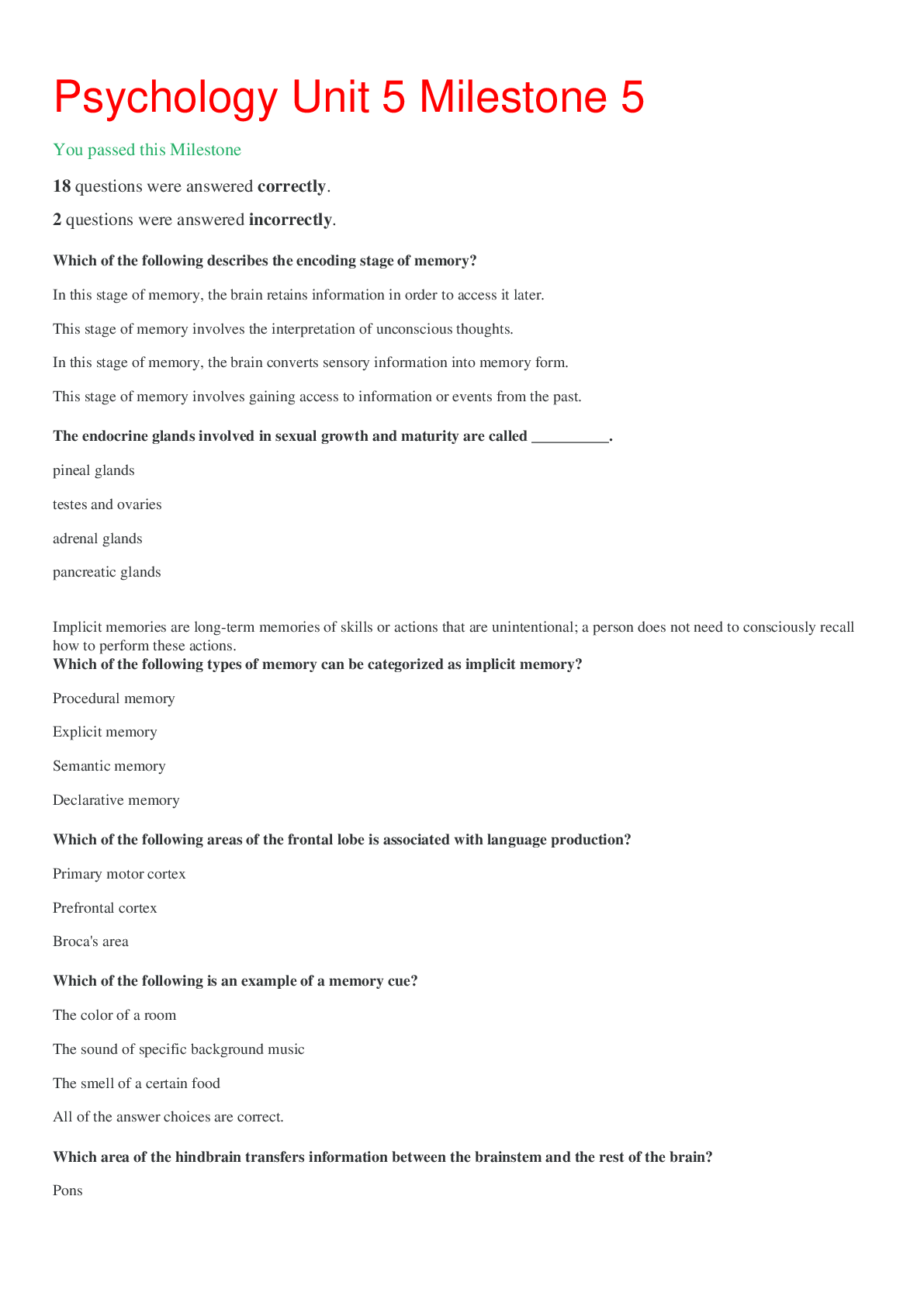Psychology > EXAM > Psychology Unit 5 Milestone 5,100% CORRECT (All)
Psychology Unit 5 Milestone 5,100% CORRECT
Document Content and Description Below
Which of the following describes the encoding stage of memory? • In this stage of memory, the brain retains information in order to access it later. • This stage of memory involves the int... erpretation of unconscious thoughts. • In this stage of memory, the brain converts sensory information into memory form. • This stage of memory involves gaining access to information or events from the past. 2 The endocrine glands involved in sexual growth and maturity are called __________. • pineal glands • testes and ovaries • adrenal glands • pancreatic glands 3 Implicit memories are long-term memories of skills or actions that are unintentional; a person does not need to consciously recall how to perform these actions. Which of the following types of memory can be categorized as implicit memory? • Procedural memory • Explicit memory • Semantic memory • Declarative memory 4 Which of the following areas of the frontal lobe is associated with language production? • Primary motor cortex • Prefrontal cortex • Broca's area 5 Which of the following is an example of a memory cue? • The color of a room • The sound of specific background music • The smell of a certain food • All of the answer choices are correct. 6 Which area of the hindbrain transfers information between the brainstem and the rest of the brain? • Pons • Cerebellum • Brainstem • Medulla 7 Injury to which of the following areas of the limbic system can result in a loss of senses? • Hypothalamus • Hippocampus • Amygdala • Thalamus 8 Mickey is a teenager who has experienced brief periods of time during his classes when he “blacks out.” Afterwards, he does not remember anything from those periods. His parents worry that he might be having seizures, so they take him to a neurologist for an examination and tests. Which of the following technologies might the neurologist use to examine the electrical activity in Mickey’s brain? • Electrical stimulation of the brain (ESB) • Electroencephalograph (EEG) • Electrode 9 Sandy is learning the alphabet. Which type of long-term memory does Sandy need to remember what she is learning? • Episodic memory • Working memory • Declarative memory 10 Which of the following glands secretes melatonin? • Pineal gland • Pituitary gland • Thyroid gland 11 Which of the following describes a computed tomography (CT) scanner? • An X-ray device that can create a 3D model of the brain • A device that uses magnetic fields to produce images of brain structures • A device that uses radioactive fluid to determine the active areas of the brain • A device that uses magnetic fields to measure blood flow 12 Which type of memory enables a person to take in information, and examine, manipulate, store, and process it for further use? • Procedural memory • Sensory memory • Working memory • Phonetic memory 13 When processing memories, an individual can consciously try to keep something out of his or her mind. Which one of the following terms best fits this description? • Proactive interference • Retroactive interference • Suppression • Repression 14 Which of the following nervous systems is made up of the brain and the spinal cord? • Somatic nervous system (SNS) • Sensory nervous system (SeNS) • Central nervous system (CNS) • Peripheral nervous system (PNS) 15 The areas on a neuron's exterior that respond to chemical molecules are called __________. • neurotransmitters • synapses • receptor sites • myelin 16 While Jim cannot remember the name of his first grade teacher off the top of his head, he quickly recalls her name when he is given a list of teachers from his primary school. Jim’s ability to select the teacher's name from a list of alternatives is an example of which of the following? • Serial position effect • Relearning • Recognition • Recall 17 The threshold of excitation refers to __________. • the point at which a neuron stops firing (i.e., stops sending an electrical impulse) • the level of impulses received from other neurons at which the receiving neuron fires (i.e., sends a neural impulse) • the voltage level of the electrical charge that travels through the neuron • the amount of energy required to open each ion channel 18 Which of the following is NOT part of the neuron? • Synapse • Axon • Myelin • Dendrite 19 Which branch of the peripheral nervous system (PNS) consists of all of the nerves that connect skeletal muscles to sensory organs? • Central nervous system • Somatic nervous system • Spinal nervous system • Sensory nervous system 20 Select the true statement about Wernicke's area. • It is the area responsible for emotions. • It is the area involved in creating meaning and understanding language. • It is the area involved in creating an understanding of visual information. • It is the area responsible for processing sensory information. [Show More]
Last updated: 1 year ago
Preview 1 out of 4 pages

Buy this document to get the full access instantly
Instant Download Access after purchase
Add to cartInstant download
We Accept:

Reviews( 0 )
$14.00
Document information
Connected school, study & course
About the document
Uploaded On
Oct 16, 2020
Number of pages
4
Written in
Additional information
This document has been written for:
Uploaded
Oct 16, 2020
Downloads
0
Views
78














